
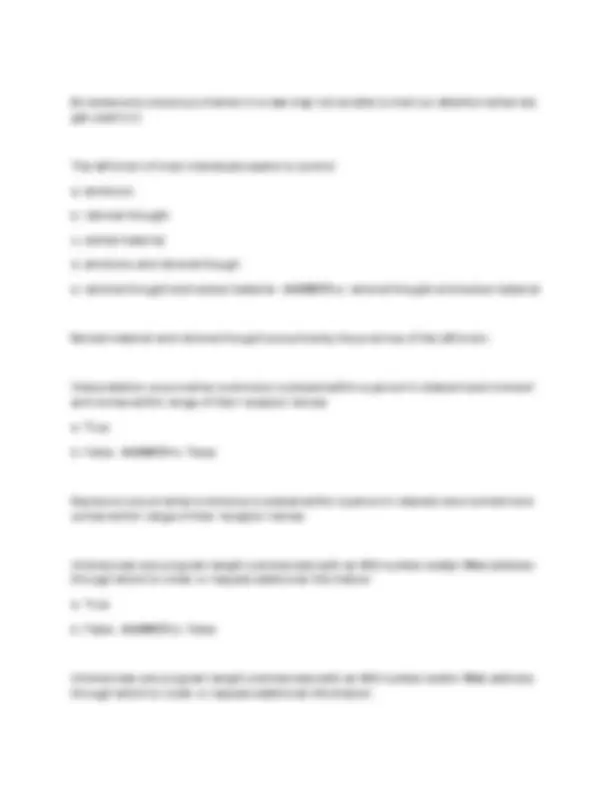
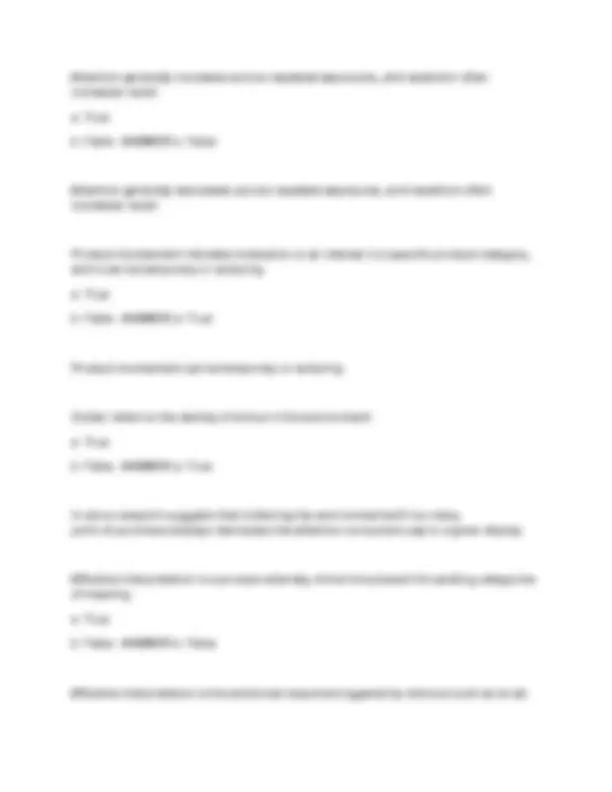
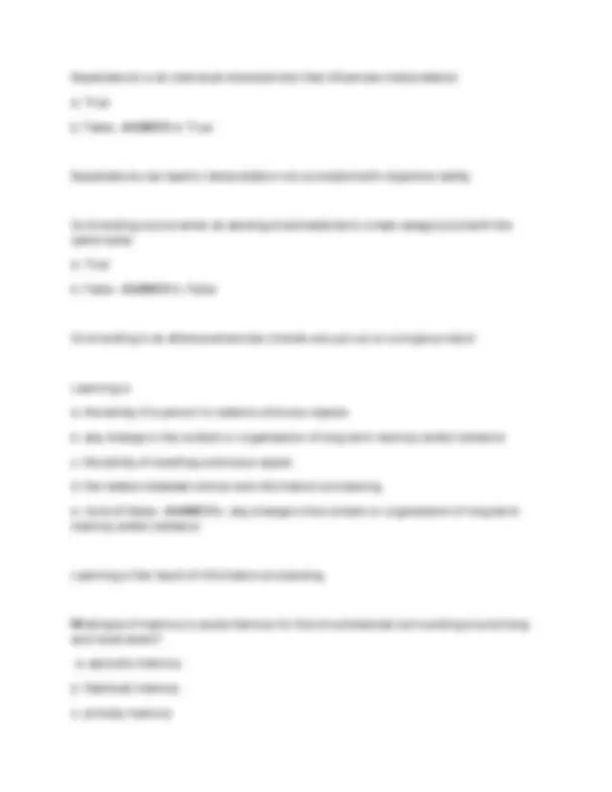
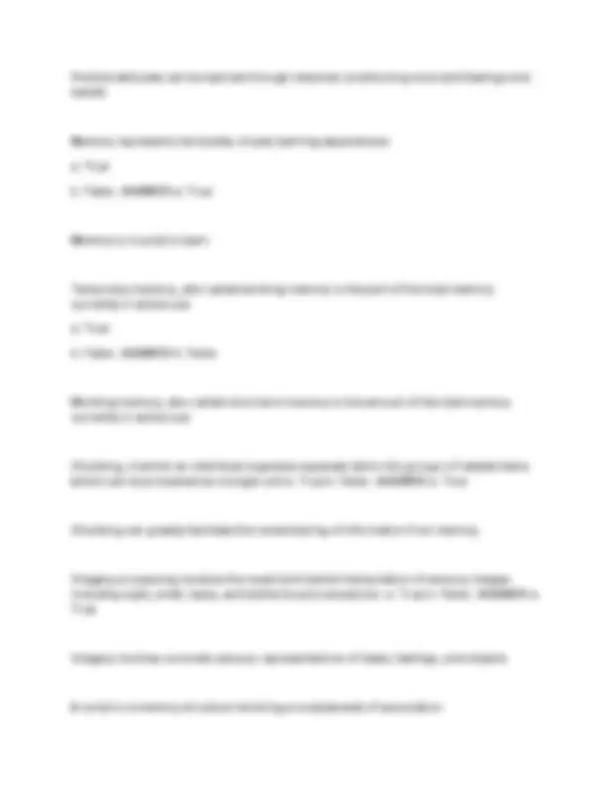
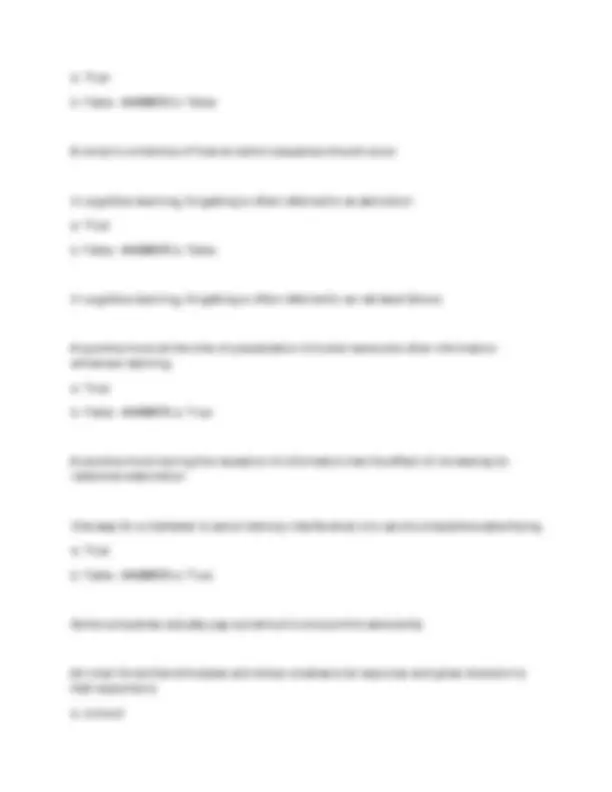
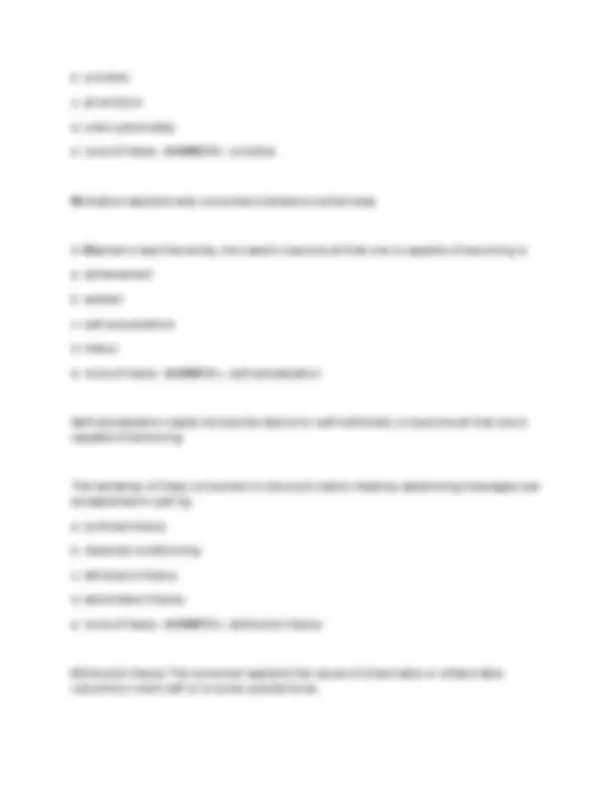
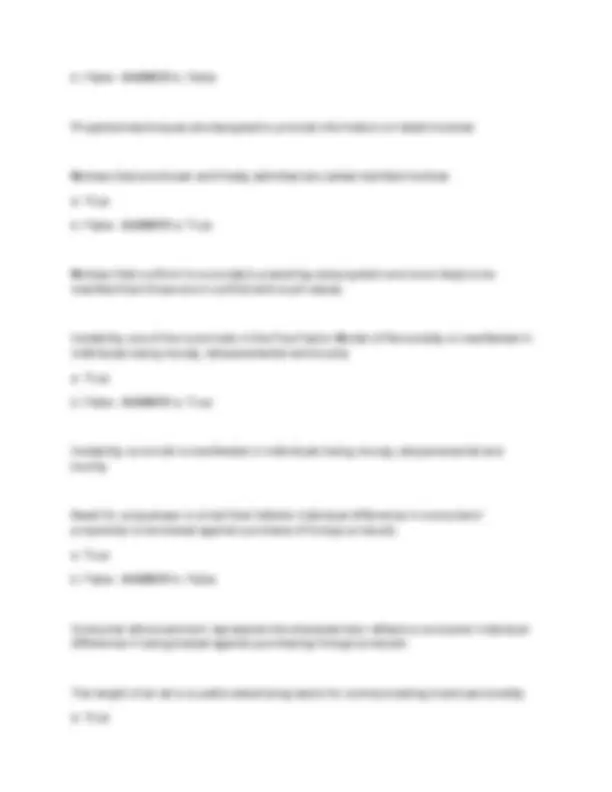
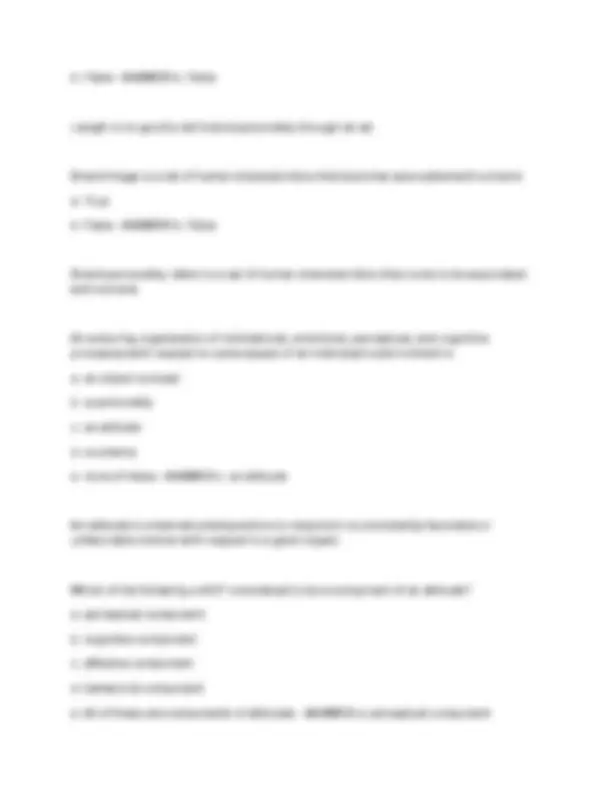
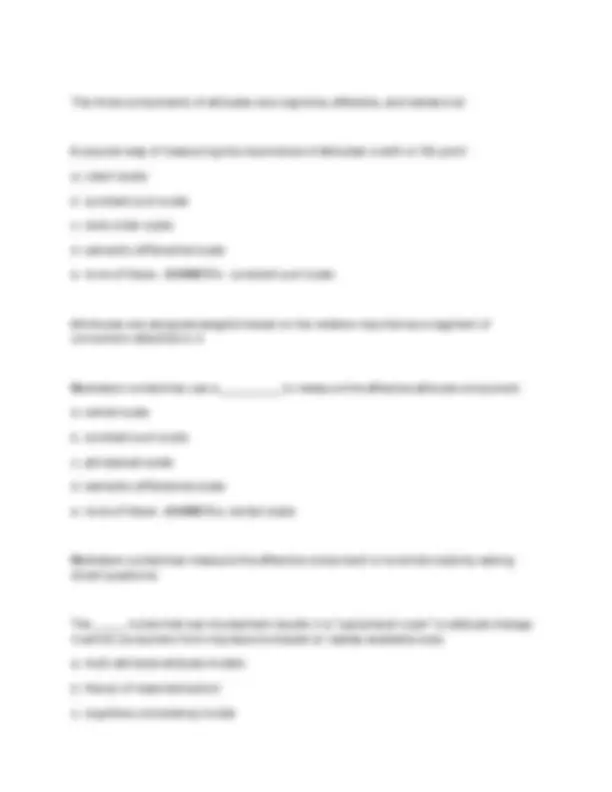
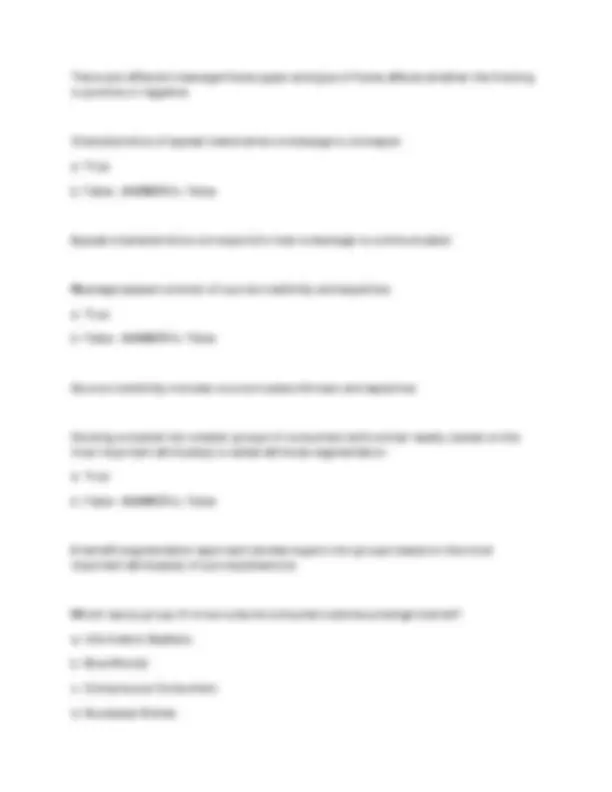
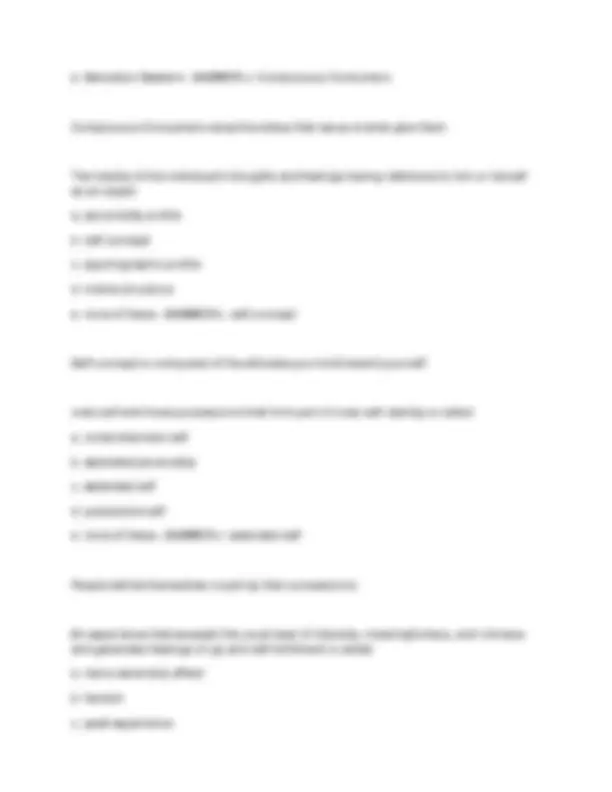
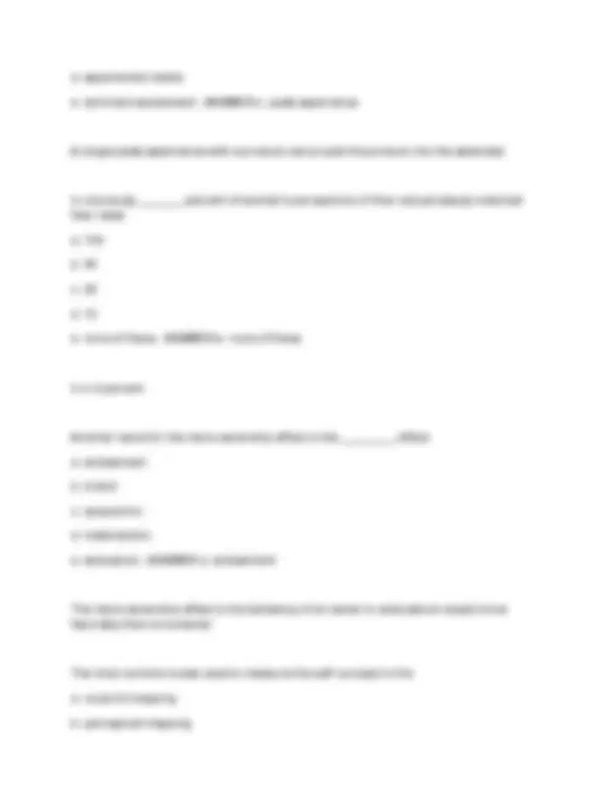
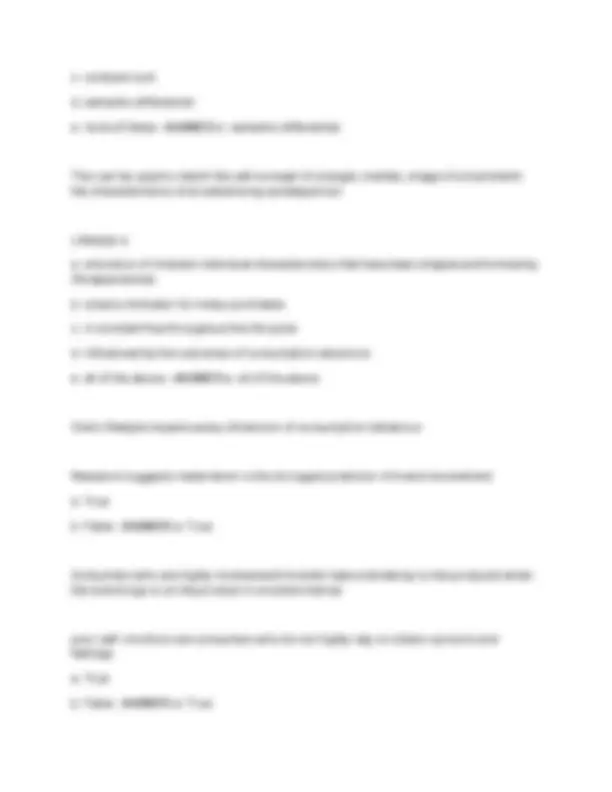
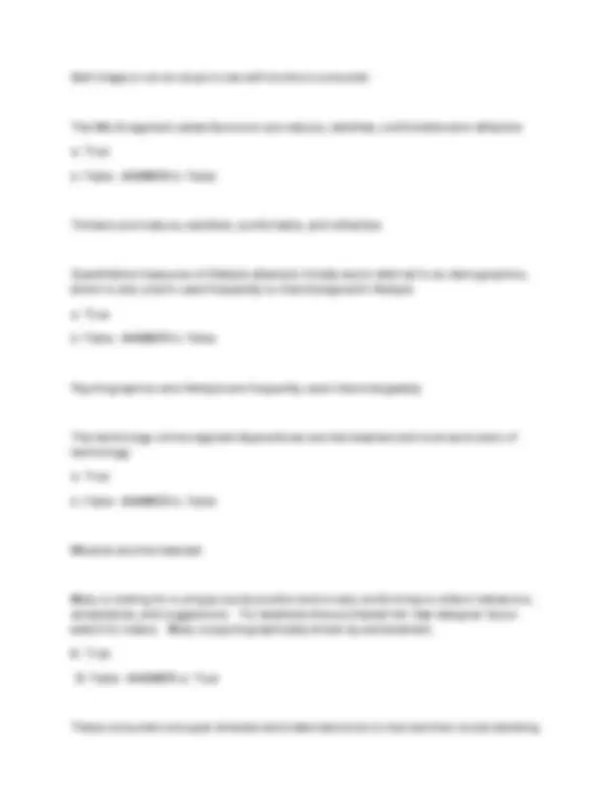
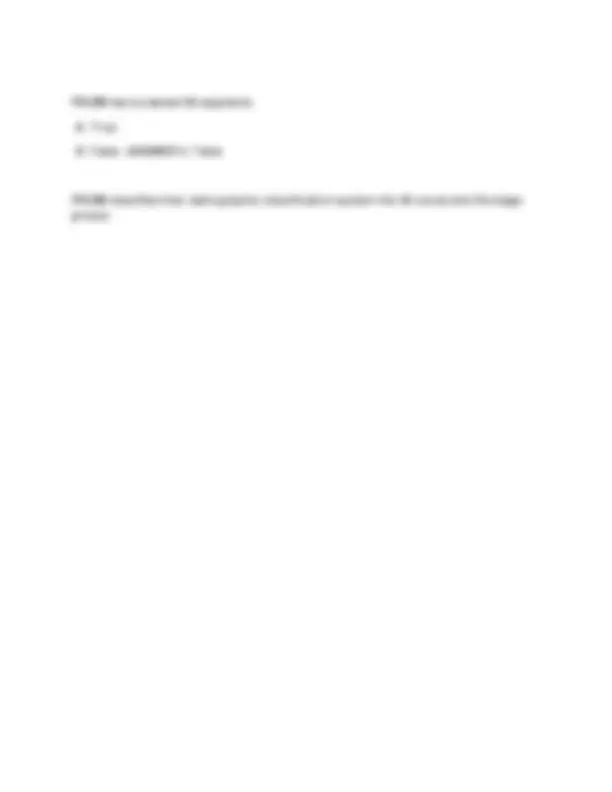


Study with the several resources on Docsity

Earn points by helping other students or get them with a premium plan


Prepare for your exams
Study with the several resources on Docsity

Earn points to download
Earn points by helping other students or get them with a premium plan
Community
Ask the community for help and clear up your study doubts
Discover the best universities in your country according to Docsity users
Free resources
Download our free guides on studying techniques, anxiety management strategies, and thesis advice from Docsity tutors
Multiple-choice questions and answers covering marketing principles, particularly consumer behavior. Topics include perception, attention, interpretation, learning, memory, and motivation. Questions test understanding of adaptation level theory, classical conditioning, attribution theory, and Maslow's hierarchy of needs. It's a study aid for marketing students, offering a concise review of essential topics and definitions. Designed to reinforce learning through a question-and-answer format, aiding knowledge retention and exam preparation. A valuable resource for testing understanding of core marketing concepts and improving assessment performance. The content facilitates quick review and self-assessment, making it effective for exam preparation and knowledge consolidation.
Typology: Exams
1 / 23

This page cannot be seen from the preview
Don't miss anything!
















Perception involves the information-processing stages of a. converting feelings into thoughts b. exposure, attention, and interpretation c. relating external and internal influences d. converting stimuli into effect e. none of these - ANSWER b. exposure, attention, and interpretation
A series of activities by which stimuli are perceived, transformed into information, and stored is called a. the adoption process b. classical conditioning c. operant conditioning d. information processing e. none of these - ANSWER d. information processing
A method marketers use to react to ad avoidance includes a. product integration b. product placement c. brand placement d. product synergy e. ad integration - ANSWER b. product placement
Product placement is defined as the incorporation of brands into media for some type of compensation
When the receptor nerves are stimulated and pass the sensations on to the brain for processing, _________ has taken place. a. cognition b. attention c. interpretation d. exposure e. none of these - ANSWER b. attention
Attention involves a controlled allocation of limited mental resources toward the processing of incoming stimuli
Which one of the following is NOT a determinant of attention? a. the stimulus b. the individual c. the situation d. the interpretation e. All of these are determinants of attention - ANSWER d. the interpretation
The same individual may give different extents of attention to the same stimulus in different situations.
_______ says that the longer consumers are exposed to constant stimuli, the more they habituate, or become blind to, those stimuli. a. subliminal stimulation b. hemispheric lateralization c. adaptation level theory d. information overload e. none of these - ANSWER c. adaptation level theory
Attention generally increases across repeated exposures, and repetition often increases recall. a. True b. False - ANSWER b. False
Attention generally decreases across repeated exposures, and repetition often increases recall.
Product involvement indicates motivation or an interest in a specific product category, and it can be temporary or enduring a. True b. False - ANSWER a. True
Product involvement can be temporary or enduring
Clutter refers to the density of stimuli in the environment. a. True b. False - ANSWER a. True
In-store research suggests that cluttering the environment with too many point-of-purchase displays decreases the attention consumers pay to a given display
Affective interpretation is a process whereby stimuli are placed into existing categories of meaning. a. True b. False - ANSWER b. False
Affective interpretation is the emotional response triggered by stimulus such as an ad.
Expectations is an individual characteristic that influences interpretation. a. True b. False - ANSWER a. True
Expectations can lead to interpretation not consistent with objective reality
Co-branding occurs when an existing brand extends to a new category but with the same name a. True b. False - ANSWER b. False
Co-branding is an alliance where two brands are put out on a single product
Learning is a. the ability of a person to relate to stimulus objects b. any change in the content or organization of long-term memory and/or behavior c. the ability of recalling a stimulus object. d. the relation between stimuli and information processing e. none of these - ANSWER b. any change in the content or organization of long-term memory and/or behavior
Learning is the result of information processing.
What type of memory is acute memory for the circumstances surrounding a surprising and novel event? a. episodic memory b. flashbulb memory c. primary memory
a. cognitive learning b. iconic rate learning c. classical conditioning d. operant conditioning e. none of these - ANSWER d. operant conditioning
Operant conditioning often involves persuading consumers to buy a particular brand or product
When scandals damage the scandalized brand but also hurt competitors in the industry, the term for this effect is a. sabotage b. discrimination c. spillover d. contrast e. contamination - ANSWER c. spillover
One of the best ways for competitors to protect against spillover from scandals is to be highly differentiated
Classical conditioning involves a. using reinforcement to alter the probability that a given behavior will be repeated b. basing one's behavior on the observed outcomes of similar behaviors by others c. based on an established relationship between a stimulus and a response, so a different stimulus will elicit the same response d. based on reasoning to create new knowledge e. none of these - ANSWER c. based on an established relationship between a stimulus and a response, so a different stimulus will elicit the same response
Positive attitudes can be learned through classical conditioning via brand feelings and beliefs
Memory represents the totality of past learning experiences a. True b. False - ANSWER a. True
Memory is crucial to learn
Temporary memory, also called working memory is the part of the total memory currently in active use a. True b. False - ANSWER b. False
Working memory, also called short-term memory is the amount of the total memory currently in active use
Chunking, in which an individual organizes separate items into groups of related items which can be processed as a single unit a. True b. False - ANSWER a. True
Chunking can greatly facilitate the remembering of information from memory
Imagery processing involves the recall and mental manipulation of sensory images including sight, smell, taste, and tactile (touch) sensations. a. True b. False - ANSWER a. True
Imagery involves concrete sensory representations of ideas, feelings, and objects
A script is a memory structure involving a complex web of association.
b. a motive c. an emotion d. one's personality e. none of these - ANSWER b. a motive
Motivation explains why consumers behave a certain way
In Maslow's need hierarchy, the need to become all that one is capable of becoming is a. achievement b. esteem c. self-actualization d. status e. none of these - ANSWER c. self-actualization
Self-actualization needs involve the desire for self-fulfillment, to become all that one is capable of becoming.
The tendency of many consumers to discount claims made by advertising messages can be explained in part by a. contrast theory b. classical conditioning c. attribution theory d. assimilation theory e. none of these - ANSWER c. attribution theory
Attribution theory The consumer explains the cause of a favorable or unfavorable outcome to one's self or to some outside force.
A consumer buys a product because a close friend bought one may be fulfilling ______ motivation. a. ego defense b. causation c. independence d. modeling e. none of the above - ANSWER d. modeling
The need for modeling reflects a tendency to base behavior on that of others.
A consumer who buys a Mercedes-Benz because she feels it communicates her image to others is satisfying a need for _______. a. attribution b. expression c. tension reduction d. reinforcement e. autonomy - ANSWER b. expression
A consumer who buys a certain brand of car because she feels it communicates her image to others is satisfying a need for expression.
Executional factors in communicating brand personality extend the core message to include "how" it is communicated using _______. a. tone b. media c. pace d. logo e. all of these - ANSWER e. all of these
b. False - ANSWER b. False
Projective techniques are designed to provide information on latent motives
Motives that are known and freely admitted are called manifest motives a. True b. False - ANSWER a. True
Motives that conform to a society's prevailing value system are more likely to be manifest than those are in conflict with such values
Instability-one of the core traits in the Five-Factor Model of Personality-is manifested in individuals being moody, temperamental and touchy a. True b. False - ANSWER a. True
Instability core trait is manifested in individuals being moody, temperamental and touchy
Need for uniqueness is a trait that reflects individual difference in consumers' propensity to be biased against purchase of foreign products a. True b. False - ANSWER b. False
Consumer ethnocentrism represents the characteristic reflects a consumer individual difference in being biased against purchasing foreign products.
The length of an ad is a useful advertising tactic for communicating brand personality a. True
b. False - ANSWER b. False
Length is no good to tell brand personality through an ad
Brand image is a set of human characteristics that becomes associated with a brand. a. True b. False - ANSWER b. False
Brand personality refers to a set of human characteristics that come to be associated with a brand.
An enduring organization of motivational, emotional, perceptual, and cognitive processes with respect to some aspect of an individual's environment is a. an object concept b. a personality c. an attitude d. a schema e. none of these - ANSWER c. an attitude
An attitude is a learned predisposition to respond in a consistently favorable or unfavorable manner with respect to a given object.
Which of the following is NOT considered to be a component of an attitude? a. perceptual component b. cognitive component c. affective component d. behavioral component e. All of these are components of attitudes - ANSWER a. perceptual component
d. elaboration likelihood model e. none of these - ANSWER d. elaboration likelihood model
Low-involvement peripheral route situations generally require limited information
Which of the following is a personal factor that can affect attitude change? a. program context b. level of viewer distraction c. buying occasion d. gender e. all of these - ANSWER d. gender
Emotional ads may add to persuasion by increasing _______. a. attention b. recall c. product liking through classical conditioning d. product liking through high-involvement processes e. all of these - ANSWER e. all of these
Emotional ads can have a variety of effects on perceptions and attitudes
Failure to consider negative reactions is a factor accounting for inconsistencies between measures of beliefs and feelings and observations a. True b. False - ANSWER b. False
Failure to consider negative reactions is not a factor accounting for inconsistencies between measures of beliefs and feelings and observations
A change importance strategy is one approach marketers employ to change the cognitive aspect of a customer attitude a. True b. False - ANSWER a. True
Most customers believe certain product attributes are more important than others.
Attitudes developed by the peripheral route are usually stronger and less vulnerable to counter persuasion efforts a. True b. False - ANSWER b. False
Attitudes formed through the central route are typically stronger and more resistant to counter persuasion efforts
An advertisement showing a person drinking a new beverage following exercise conveys usage information a. True b. False - ANSWER a. True
Non-verbal advertising content may also have an effect on cognitions regarding a product
Framing of messages refers to the way marketers frame one of two logically equivalent value outcomes either in the positive, or gain, terms, or in negative, or loss terms. a. True b. False - ANSWER a. True
e. Sensation Seekers - ANSWER c. Conspicuous Consumers
Conspicuous Consumers value the status that luxury brands give them
The totality of the individual's thoughts and feelings having reference to him or herself as an object a. personality profile b. self-concept c. psychographic profile d. motive structure e. none of these - ANSWER b. self-concept
Self-concept is composed of the attitudes you hold toward yourself
ones self and those possessions that form part of ones self-identity is called a. comprehensive self b. extended personality c. extended self d. possessive self e. none of these - ANSWER c. extended self
People define themselves in part by their possessions
An experience that exceeds the usual level of intensity, meaningfulness, and richness and generates feelings of joy and self-fulfillment is called a. mere ownership effect b. fandom c. peak experience
d. experiential media e. dominant excitement - ANSWER c. peak experience
A single peak experience with a product can propel the product into the extended
In one study ________ percent of women's perceptions of their actual beauty matched their ideal a. 100 b. 90 c. 20 d. 10 e. none of these - ANSWER e. none of these
It is 2 percent
Another name for the mere ownership effect is the __________ effect. a. endowment b. brand c. acquisition d. materialistic e. evaluation - ANSWER a. endowment
The mere ownership effect is the tendency of an owner to evaluate an object more favorably than a nonowner
The most common scale used to measure the self-concept is the a. conjoint mapping b. perceptual mapping